
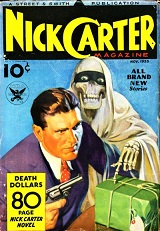 Nick Carter, Master Detective (1943-1955) aired “The Case of the Star of Evil” on April 4, 1948 as its 334th episode. This is only the 9th Nick Carter episode we’ve run since 2009, the last being in June of 2017. Carter’s history is long, covers numerous media, and is one of the more fascinating we’ve come upon. To crib from one of our earlier entries for new listeners, and slightly tweaked with new material, Nick Carter on radio ran a respectable twelve years, from 1943-1955, but the famous detective’s history begins much earlier. During the post-Civil War era known as Reconstruction, a short story featuring Carter appeared in an obscure fiction paper (The New York Weekly) in 1886 (predating the first Sherlock Holmes story by two years). The publisher was none other than Street & Smith, a fledgling, struggling publishing firm which would later become the most dominant pulp magazine publisher in the world. Among its later titles would be Astounding Science Fiction (now Analog), the only magazine from Street & Smith to survive the pulp magazine crash of the 1950s.
Nick Carter, Master Detective (1943-1955) aired “The Case of the Star of Evil” on April 4, 1948 as its 334th episode. This is only the 9th Nick Carter episode we’ve run since 2009, the last being in June of 2017. Carter’s history is long, covers numerous media, and is one of the more fascinating we’ve come upon. To crib from one of our earlier entries for new listeners, and slightly tweaked with new material, Nick Carter on radio ran a respectable twelve years, from 1943-1955, but the famous detective’s history begins much earlier. During the post-Civil War era known as Reconstruction, a short story featuring Carter appeared in an obscure fiction paper (The New York Weekly) in 1886 (predating the first Sherlock Holmes story by two years). The publisher was none other than Street & Smith, a fledgling, struggling publishing firm which would later become the most dominant pulp magazine publisher in the world. Among its later titles would be Astounding Science Fiction (now Analog), the only magazine from Street & Smith to survive the pulp magazine crash of the 1950s.
(Cover above left from the November 1933 issue of Nick Carter Detective Magazine)
Award-winning radio historian Elizabeth McLeod notes that, “Within a decade, an ongoing series of Nick Carter novels vaulted [Street & Smith] to the front ranks of dime-novel publishers, and made Nick himself a national institution. Nick’s own magazine, The New Nick Carter Weekly, would carry the detective into the twentieth-century.” By 1915, however, the then titled Nick Carter Weekly became Street and Smith’s Detective Story Magazine, a true pulp magazine and S&S’s initial entry into this new format. Again, from Elizabeth McLeod: “Detective Story Weekly soon became Street and Smith’s flagship publication. With the rise of radio in the 1920s, it became the firm’s entree into the broadcast medium. The Street and Smith Detective Story Hour became a favorite of listeners at decade’s end, with elaborate tales of murder and crime hosted by a mysterious narrator introduced only as “The Shadow.” While Nick Carter himself did not appear on the program, his spirit was very much in evidence in the various detective characters that populated the stories.” Of course, we all know what happened next. The mysterious voice only introducing the S&S Detective Story Hour became so popular that S&S launched The Shadow magazine in 1931, and shortly thereafter S&S added Doc Savage to its pulp adventure line. Amidst all of this activity Nick Carter was even given his own magazine (again) in 1933, proving the character’s resiliency and staying power–he was now 47 years old.
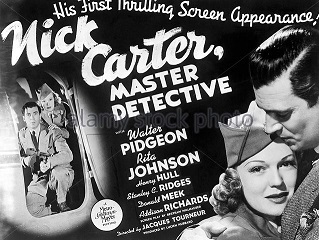 Nick Carter Magazine ran for 40 issues, from March 1933 to June 1936, the final six issues slightly retitled as Nick Carter Detective Magazine. While the magazine had folded, its long-running character still lived, for in 1939 Hollywood picked up the movie rights and produced three “B” Carter films starring noted actor Walter Pidgeon (who later would star in the classic 1956 SF film Forbidden Planet).* A mere three years later, Nick Carter would rise from the dead yet again in his own radio series, Nick Carter, Master Detective. The show’s producer and often the writer, Sherman “Jock” MacGregor, would enlist some of the best writers in the business to script Carter’s episodes, including Robert Arthur and David Kogan of Mysterious Traveler fame, the creator of The Shadow, Walter Gibson, and none other than legendary SF author Alfred Bester (one of which Bester-written episodes, “Chemical Chickens,” we ran in March of 2014 here). Lon Clark played Nick Carter throughout its 12-year run, ably supported by first Helen Choate until mid-1946 and then Charlotte Manson (photo at right with Lon Clark) as Nick’s intelligent, perky secretary Patsy Bowen. Other mainstay characters included Police Sergeant Matty Mathieson, young newspaper reporter Scubby Wilson, and scruffy old veteran of the crime game Waldo McGlynn.
Nick Carter Magazine ran for 40 issues, from March 1933 to June 1936, the final six issues slightly retitled as Nick Carter Detective Magazine. While the magazine had folded, its long-running character still lived, for in 1939 Hollywood picked up the movie rights and produced three “B” Carter films starring noted actor Walter Pidgeon (who later would star in the classic 1956 SF film Forbidden Planet).* A mere three years later, Nick Carter would rise from the dead yet again in his own radio series, Nick Carter, Master Detective. The show’s producer and often the writer, Sherman “Jock” MacGregor, would enlist some of the best writers in the business to script Carter’s episodes, including Robert Arthur and David Kogan of Mysterious Traveler fame, the creator of The Shadow, Walter Gibson, and none other than legendary SF author Alfred Bester (one of which Bester-written episodes, “Chemical Chickens,” we ran in March of 2014 here). Lon Clark played Nick Carter throughout its 12-year run, ably supported by first Helen Choate until mid-1946 and then Charlotte Manson (photo at right with Lon Clark) as Nick’s intelligent, perky secretary Patsy Bowen. Other mainstay characters included Police Sergeant Matty Mathieson, young newspaper reporter Scubby Wilson, and scruffy old veteran of the crime game Waldo McGlynn.
*(The first of the three Nick Carter films was 1939’s Nick Carter, Master Detective. Of interest to genre buffs is that it was directed by Jacques Tourneur, now famous for directing the following trio of Val Lewton horror films: Cat People (1943), I Walked with a Zombie (1943), and The Leopard Man (1943).)
From Nick Carter’s beginnings in 1886 through his final radio show in 1955, Carter would change with the times; from clean-living detective (actually, at the beginning of his career, Nick was a private investigator and consulting detective to the police department, much like Sherlock Holmes, and did not work as a police detective), master of disguise, to anti-espionage agent, to the bane of mad scientists or the defender of scientists beset by crooks, Nick Carter has enjoyed one of the longest surviving, most popular runs in various media for over 100 years, for when his radio show ended in 1955 he would resurface (yet again!) in a series of James Bond-type paperback novels in the 1960s which ran into the 1990s, quite a few of them written by women.
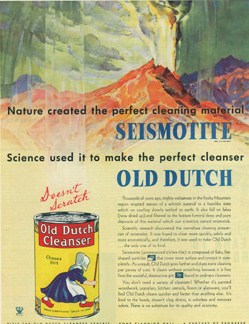 Virtually forgotten today, Nick Carter predates Dashiell Hammett’s Sam Spade, Raymond Chandler’s Philip Marlowe, and was originally inspired by the real-life exploits of private investigator Allan Pinkerton. And though this episode isn’t of the SF genre, one of the show’s sponsors has a product with a decidedly pulpish SF sounding name (which is chuckle-worthy to modern sensibilities). The sponsor is Old Dutch Cleanser and it touts its main ingredient as Seismotite. The ad pictured at right is from 1934 and this radio episode is from 1948, so it looks like Old Dutch Cleanser and Seismotite were enjoying a pretty good run, though their rival, Johnson’s (with a whole line of products including Johnson’s Wax), would eventually prevail.
Virtually forgotten today, Nick Carter predates Dashiell Hammett’s Sam Spade, Raymond Chandler’s Philip Marlowe, and was originally inspired by the real-life exploits of private investigator Allan Pinkerton. And though this episode isn’t of the SF genre, one of the show’s sponsors has a product with a decidedly pulpish SF sounding name (which is chuckle-worthy to modern sensibilities). The sponsor is Old Dutch Cleanser and it touts its main ingredient as Seismotite. The ad pictured at right is from 1934 and this radio episode is from 1948, so it looks like Old Dutch Cleanser and Seismotite were enjoying a pretty good run, though their rival, Johnson’s (with a whole line of products including Johnson’s Wax), would eventually prevail.
“The Case of the Star of Evil” has Nick doing an odd gig for him; he’s being paid to do public relations for an East Indian maharaja (maharaja is from the sanskrit and means “great king”). The maharaja is rich beyond belief and wears a hundred carat diamond named “The Star of Evil” in the center of his turban. Of course, there are many who woul do anything to be in possession of such a jewel, its worth estimated to be in the realm of a quarter of a million dollars. Soon enough and despite precautions the gem is stolen, a murder has been committed, and it is up to Nick to find the thief and murderer as quickly as possible. One suspect after another is discarded until the culprit (as many seem to do) makes a small slip and gives himself away. But from listening to the story it isn’t the most likely suspect at all, so see if you can figure out who the thief/murderer really is, in “The Case of the Star of Evil.”
Play Time: 26:08
[Springtime for the neighborhood gang brought melting snow, and active imaginations saw dead bodies partly uncovered in piles of brush or simple mounds of dirt (well, a lost glove or shoe protruding partway through melting snow had to belong to a human hand or foot further below, right?). Nevertheless, after listening to this episode of Nick Carter, they girded their jean-clad loins and headed for the local newsstand for more of the same. Dime Detective Magazine (1931-53) was a long-running and stable entry into the detective genre magazine ranks and when the mood hit the gang was a sure choice. It was a reliable monthly in 1948. Dime Mystery Magazine (1932-50) also a favorite, guaranteed its share of murder, mayhem, and mystery with every issue. It was a monthly until 1941 when it switched to a bi-monthly format. The Phantom Detective (1933-53) was one of several “cool” detective pulps the gang sought when the mood hit them, for, like the Shadow and the Green Hornet, who disguised themselves either with invisibility or a mask, so too did the mysterious Phantom Detective disguise his true identiy by wearing a mask as he battled evil in all of its forms (and usually saved a damsel in distress along the way). The Phantom Detective was a regular bi-monthly until 1949 and then went to a quarterly schedule until the end of its run.]
[Left: Dime Detective, April 1948 – Center: Dime Mystery, April 1948 – Right: The Phantom Detective, May 1948]
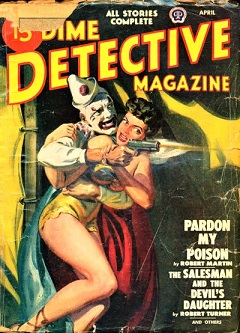
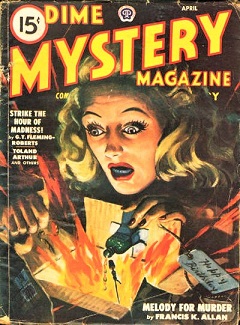
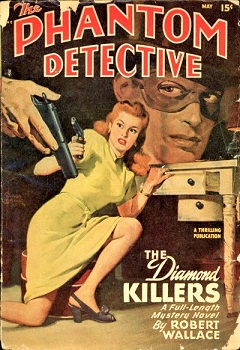
To view the entire list of weekly Old Time Radio episodes at Tangent Online, click here.